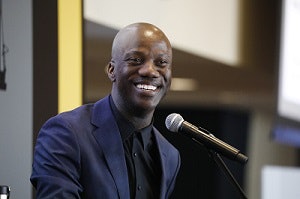Dr. Shaun Harper, executive director of the University of Southern California’s Race & Equity Center, couldn’t sleep on Saturday night as he looked at his inbox full of emails from college administrators asking for guidance as anti-racist protests spread across the country. He got up at 3:30 a.m. the next day and sent an email to all 115 community college presidents in California.
That message launched the California Community College Equity Leadership Alliance, a new partnership between more than 60 community colleges to combat racism on their campuses.
 Dr. Shaun Harper (Photo by: Steve Cohn)
Dr. Shaun Harper (Photo by: Steve Cohn)“Here is a way we can take a united stance against racism,” Harper said. “Beyond simply proclaiming that Black lives matter and racism is bad, beyond the statements that each of you has written to your campus communities. Here is a specific set of actions … we can take together as an alliance to actually confirm that Black lives matter, to actually confirm that racial equity is important beyond the trendiness of saying so in this current moment.”
An “epiphany” born five months ago, but delayed by the COVID-19 pandemic, Harper wants to address racial inequity at California’s community colleges “more efficiently and more effectively” than fielding individual requests for help.
After the death of George Floyd – a Black man in Minnesota who died in police custody after an officer kneeled on his neck – that work took on an extra sense of urgency, with Black students and staff frustrated by university statements of outrage without concrete action plans, he said. So, the alliance is designed to help California’s community colleges design and implement proactive strategies.
“This is what action looks like,” Harper added.
Colleges in the alliance will each pay the Race & Equity Center $25,000 a year to be part of the alliance, and in return, they will have access to specialized tools, resources and guidance.
One resource is a new annual eConvening series, where scholars, chief diversity officers and higher education leaders will teach a dozen four-hour learning modules on different aspects of racial equity over the course of the year. Colleges will send five employees to each module, and after every lesson, they will submit a worksheet with a plan for a strategic action addressing the inequity discussed on their campus. The center will respond to worksheets with personalized feedback.
That means, at the end of the year, each college will effectively have a “12-dimensional strategic racial equity action plan,” Harper said.
The series will focus on hiring and retaining faculty of color, confronting acts of racism on campus, using survey data to improve campus racial climate, addressing tensions between faculty of color and closing racial gaps in student transfer rates, among other topics. In each learning module, instructors will also spend an hour on how staff can teach what they’ve learned to their colleagues.
Dr. Pamela Luster, president of San Diego Mesa College, hopes the discussions will help her campus tackle the inequities of remote learning for students of color amid the pandemic, like disparate access to technology, unequal “academic capital” to feel confident in an online classroom, and more broadly, “the intersection of poverty and race.”
“It’s the right time for more people to step forward and join these conversations, especially White allies and others that maybe didn’t feel like they had the tools to do that work,” she said.
For each college in the alliance, the center will also facilitate two new campus-wide surveys – one survey for faculty and one for staff – in addition to its existing campus climate survey, the National Assessment of Collegiate Campus Climates.
Campus climate surveys that focus on university employees are “incredibly uncommon,” Harper said. “But … there are really significant racial issues in the higher education workforce.”
The new surveys will focus on issues like equitable opportunities for promotion among staff, employees’ experiences of discrimination and their level of satisfaction with how the college responds to reports of unfair treatment, abuse and climate problems. Each college can conduct all three surveys over the course of three years of membership – the student survey first, the faculty survey second and the staff survey third. And after three years, they can repeat the cycle of surveys to see how they’ve changed. The center will collect and analyze the data, and each college will receive a report with the results and concrete recommendations for improvement.
Colleges will also have access to a virtual equity resource portal with equity-focused rubrics, readings, case studies, slide shows, videos and conversation scripts. Employees will be able to post questions for experts at the center, which they will answer with two-page briefs summarizing relevant research and evidence-based practices.
Luster sees the alliance as a “good use of resources” for community colleges, which don’t necessarily have resources to spare, she said. It exposes a group of people on each campus to new skills and gives community colleges an opportunity to work on racial inequities as a cohort.
“As institutions, we can get kind of insular,” she said. “Right now is the time for us to really reach out to people who’ve studied these issues for a long time – and to be able to look at our own practices as community colleges so the experiences our students of color are having are more equitable and accessible.”
Sara Weissman can be reached at [email protected].





















